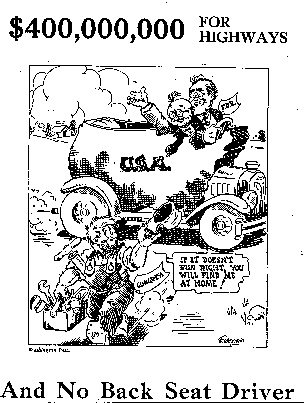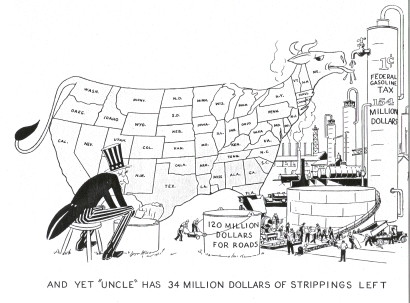Origins of the Interstate System
Part 2 of 7
In October, Frank T. Sheets, former Chief Highway Engineer of Illinois, voiced concerns that were typical of the time:
THE RATIONAL PLANNING BY A STATE OF A PUBLIC HIGHWAY PROGRAM
Rational planning is the salvation of the highway industry. Lack of it spells ruin. The alarming invasion of road funds evidenced in recent years, climaxed by the diversion of hundreds of millions of highway dollars to uses utterly foreign, and accompanied by the crippling of state highway departments and grave cessation of construction activity, can only be stopped by arousing public opinion to the fighting pitch of positive action.
As an aid to arousing public opinion, we must develop rational plans for the highway programs in the states, embracing equitable distribution of highway revenues and adequate treatment of all classes of thoroughfares-both rural and urban, and then we must sell the plans to the public. This accomplishment will so popularize the highway movement, that highway funds will be cheerfully raised, and an alert citizenship will safeguard them for their intended use.
The day of highway hysteria is over. The bubbling good roads booster, with his sentimental appeal, must be replaced by the highway economist armed with sound plans, fundamental facts regarding the dividend producing aspects of improved highways and convincing proof of the equity of proposed highway tax collection and distribution.
Inevitably the burden of leadership in this important work falls upon the state highway official. He can command the knowledge and facilities for sound highway planning based upon traffic studies, economic surveys and kindred data; he commands the attention of the individual citizen and organized civic groups; and he, more than any one else, can educate representative citizens and civic groups so that they in turn may sell the highway program to the public at large. Failure to measure up to this responsibility is unthinkable.
A state-wide traffic survey is almost indispensable as a guide to rational highway planning. It should develop complete information regarding the volume, character and distribution of traffic on city streets, primary or state, secondary or county trunk and tertiary or township highways.
The economic surveys recently conducted by the United States Bureau of Public Roads in Wisconsin, Michigan and Illinois are striking illustrations of this work. They have been carried out with a thoroughness which engenders confidence and commands respect. They are invaluable, not only to the people of those States, but to highway economists, engineers and administrators everywhere. They merit careful study and reveal the type of information which is essential to the development of rational highway programs. The Bureau cannot be too strongly commended for having instituted these surveys and for having developed the technique of performing the work. Although a veritable mass of information has been procured in them, such surveys are relatively inexpensive. The States should take advantage of the help which the Bureau can give on these basic studies.
At regular periods and seemingly about every 10 years, each State faces a new deal in highway affairs. Most States are now reaching a stage of highway development when clear thinking and rational planning are essential for a stabilized highway future. This situation must be met.
In accomplishing this aim the following steps will be helpful:
- The making of traffic and economic surveys.
- The creation by legislative authority of a broad gauged commission to study such surveys and to plan the future highway program.
- The presentation of the findings and recommendations of this commission in a concisely written understandable report.
- The selling of such recommendations to the public and to the legislature by means of news releases, pamphlet distribution, public meetings, etc.
- The expression of the commission's recommendations in legislative bills.
- The passage of the bills.
- The translation of legislative enactments into highway accomplishment, accompanied by public confidence and popular approval.
After a long period of no recorded speeches, presumably attributable to the change of administrations, Mr. MacDonald presented the details of the radically new National Industrial Recovery Act in an article in the Engineering News Record in December of 1933. This is an excerpt:
FEDERAL DIRECTION OF PROGRAMMING AND ENGINEERING OF EMERGENCY ROAD WORK
- $3.3 billion was appropriated for all public works with $400 million of that apportioned to the State highway departments.
- Provision was made for the allotment of apportioned highway funds to the Federal-aid highway system, to municipal extensions and to secondary and feeder roads.
- Employment features:
- No convict labor.
- 30-hour week.
- A standard of living of decency and comfort.
- Preference to residents of the county or local subdivision where the projects are with priority to veterans with dependants.
- Maximum labor intensiveness in lieu of machinery.
Administrative rules issued by the Sec. of Agriculture:
- One or more projects in 75% of all counties within the State.
- 25% of the apportioned funds to go to extensions of the Federal-aid system in municipalities.
- The highway departments were required to submit a list of the amount of money proposed for each of the 3 categories of roads and a list of the counties where the projects would be located.
- Augmentation of engineering staffs was required in many cases, especially where cut backs had been made due to the Depression.
- Money advances were made to the States where needed.
- Authority was delegated to the field to approve advertising of projects.
- Project advertising time reduced to two weeks.
- Authority to approve P.S.&E. delegated from the Secretary of Agriculture to the Chief of BPR.
- Plans for secondary roads prepared while work in progress.
- Continuance of work throughout the winter insisted upon.
- Hand labor wherever possible.
- Minimum wage rates established for urban:
- Skilled $1.00, labor $0.65, unskilled $0.45 in Southern States.
- $1.10, 0.70, 0.45 in Central States
- $1.20, 0.75, 0.50 in Northern States
- Wage rates in rural areas to be not more than 25% below urban.
- To preserve the labor intensity of Federal funds, no participation in rights-of-way or PS&E.
- Limitations were placed upon secondary road funds to prevent squandering on disconnected segments. No formal requirement for system designation, however.

The order of priority assigned to projects:
- Closing of gaps in the Federal-aid highway system.
- Landscaping of parkways and roadsides.
- Supplementing of existing transportation facilities-rail, air, freight terminals, airports and emergency landing fields.
- Elimination of hazards to highway traffic including grade crossing separations, widening of narrow bridges and roadways, building of foot paths, replacement of unsafe bridges, bypasses of congested areas and improvement of accessibility and the free flow of traffic.
A set of design standards for secondary roads was issued. The attached cartoon was published in the same issue of American Highways.

Note that this was not the regular Federal-aid program. The funds had no matching requirement and caused the highway departments to construct local and urban roads for the first time. Also note that a plan and program was required for the major roads before work could begin. The record shows that the $3.3 billion program was well developed and on its way to passage when AASHO officials persuaded the Congress to deliver $400 million through BPR. Some of the rest of the $3.3 billion also found its way into highways, delivered directly to municipalities, counties and other special entities. Some of it came under the supervision of the highway departments at the local level, most of it did not. There was a great deal of overlap and confusion.
In January of 1934, MacDonald addressed the American Roadbuilders' in Chicago. He noted that there were many suggestions that the way to relieve unemployment was to build a transcontinental highway. He presented statistics to show that the program had already begun building the equivalent of three transcontinental highways from July 1933 to January of 1934. He described the emergency program and gave a progress report. He noted that urban projects were lagging because it was a new field and plans were not on the shelf and the designs were complicated. 132,000 additional jobs were on the payrolls in Nov. He noted that completion of the extant appropriations would end the Federal highway program unless further legislation was passed to provide for continuance.
The results of this program were devastating to the State highway departments. The 100% Federal share of funds accelerated the diversion of State highway-user revenues because, as the legislatures saw it, the highway departments had no need of State revenues since they had more Federal money than ever before and no need for matching.
Vast mileages of minor roads were transferred to State jurisdiction without any revenue to go with them because that's where the 100% Federal money was and tax revenues were drying up. The emphasis on labor intensive projects on minor roads completely inverted the economic efficiency ethic that had prevailed through the Golden Age. The main coast-to-coast routes suffered at the expense of minor projects. The funds, although they generated employment, did not provide nearly as much as if the regular Federal-aid 50-50 matching program had been in place.
It was these problems that led to the passage of the Hayden-Cartwright Act in 1934 which provided for a return to the regular program in 1936. The rampant diversion of State user revenues led to the section of the Act prohibiting diversion by the States. It also provided for the beginning of the 1 1/2% planning program to start the planning surveys that were believed to be the vehicle for public and legislative awareness of the highway program problems.

